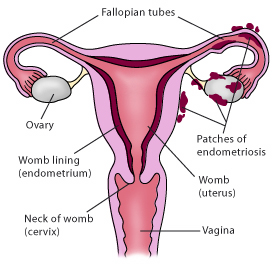What is the endometriosis disease?
Endometriosis is a common condition affecting women. It is a chronic, painful, and often progressive disease in women. The causes of <stong>endometriosis</stong> are unknown.It has widel variability in symptoms and severity, so diagnosis is at times difficult.
Endometrial Implants
Endometriosis occurs when cells from the mucus membrane lining the uterus (endometrium) form implants that attach, grow, and function outside the uterus, generally in the pelvic region.

Endometrial implants consist of both following cell types:
- Gland cells. These cells secrete hormones and other fluids and are normally located in the uterine lining.
- Stroma cells. These are the framework cells that build supportive tissue.
Endometrial cells contain receptors that bind to estrogen and progesterone, which promote uterine growth and thickening. During endometriosis these cells become implanted in organs and structures outside the uterus, where these hormonal activities continue to occur, causing bleeding and scarring.
Endometrial implants vary widely in size, shape, and color. Over the years, they may diminish in size or disappear or they may grow.
- Early implants are usually very small and look like clear pimples.
- If they continue to grow they may form flat injured areas (lesions), small nodules, or cysts calledendometriomas, which can range from sizes smaller than a pea to larger than a grapefruit.
- Implants also vary in color; they may be colorless, red, or very dark brown. These so-called chocolate cysts are endometriomas filled with thick, old, dark brown blood that usually appear on the ovaries.
Location of Implants
Implants can form in many areas…





